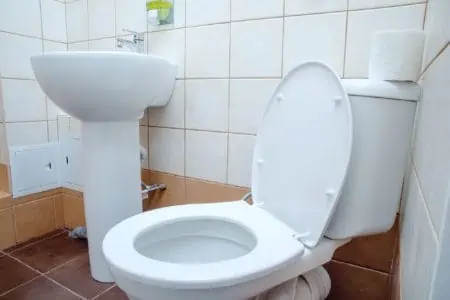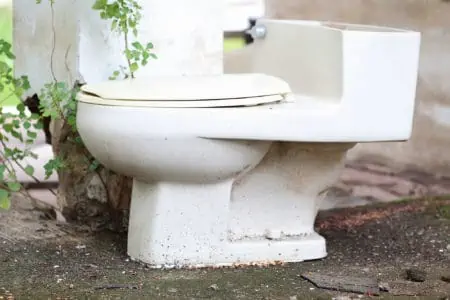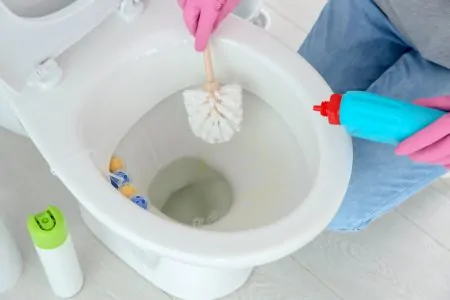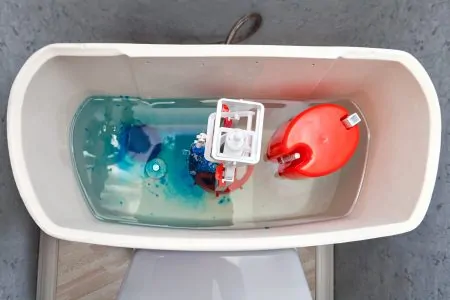“Why did my toilet seat turn blue?” Not exactly a common question, but there’s merit behind it. It happens. But why?
You might have heard about toilet seats turning blue when pregnant. It’s not exactly something that pops off naturally in a conversation, but some forum users claim this is a true phenomenon.
We wanted to see if there’s an explanation behind this or if it’s pure coincidence. If you ever saw your toilet seat turning blue or changing color with black marks, we might have some answers for you.
Key Takeaways
- Pregnancy hormonal changes can cause toilet seats to turn blue due to increased estrogen and progesterone levels affecting skin pH.
- Blue clothing, particularly new jeans, may bleed dye onto the toilet seat, causing it to change color.
- Chemical reactions from cleaning products, bacteria, or dyes on the toilet seat can also result in a blue hue.
- Chromhidrosis and pseudochromhidrosis are rare conditions that can cause color changes, but they are unlikely culprits for a blue toilet seat.
Why is My Toilet Seat Turning Blue?
There’s lots of speculation about what might cause it, but many are still in the dark about why toilet seats turn blue.
Pregnancy Hormonal Changes
You may have heard of the phenomenon of blue toilet seats during pregnancy. And, when Googling about toilet seats turning blue or purple, pregnancy will pop up very often. That’s because so many changes (and plenty of hormone imbalance) are happening during this time.
Pregnancy brings along an increase in prolactin, estrogen, progesterone, and oxytocin, to name a few. However, there is no scientific data to support the theory that this might cause color changes in the toilet seat.
Birth Control
Wondering if the toilet seat can turn blue even if you’re not pregnant? You’re not alone. Some women have claimed that their toilet seats started turning blue after they started taking birth control.
The potential explanation would be, once again, hormonal changes and an increase that would potentially cause pH chances in the sweat.
Prenatal Vitamins
It is even believed prenatal vitamins can cause the toilet seat to turn blue due to one of its ingredients.
However, there is no evidence to fully support that theory. Most of the ingredients found in prenatal vitamins are already part of your diet. So, if this theory were true, you should have spotted a blue toilet seat before taking them.
Chromhidrosis
Is pregnancy not a reasonable explanation because you’re male? Chromhidrosis is an uncommon disorder in which an abnormally high level of lipofuscin is found in the sweat glands of the affected individual. People who have this condition can have different colored sweat, with blue being one example.
However, there are reasons why this theory may not ring true for your toilet seat turning blue. First of all, chromhidrosis isn’t that common during pregnancy (or at all).
Secondly, if you have chromhidrosis, colored sweat has three possible locations: breasts, armpits, and the face. None of these body parts come in contact with the toilet. And lastly, there is no medical literature to support this theory.
Pseudochromhidrosis
Known for being a condition that mimics chromhidrosis, pseudochromhidrosis doesn’t exactly cause colored sweat.
Instead, the excreted sweat is clear in color. But when coming into contact with certain chemicals, fungi, bacteria, or dyes on your toilet seat or skin, the chemical reaction causes it to change color.
There is a theory that if antibacterial silver is used to coat the toilet seat, it could cause a pseudochromhidrosis reaction when coming into contact with perspiration.
However, this is something that could easily be tested and would not only impact a person while they are pregnant.
Blue Clothing
If you’ve asked, “Why did my toilet seat turn blue?” this is one of the most plausible reasons. Your toilet seat turning blue is most likely because of blue clothes bleeding dye.
It’s not uncommon for a new pair of jeans to leave dye stains on your skin. So it’s reasonable to conclude that they’re likely to leave it on the toilet seat, too, especially if they’re new and yet to be washed.
Toilet Bowl Cleaner Stains
Out of all these potential blue toilet seat causes, blue clothing and toilet bowl cleaner stains are the most likely ones. As you know, many toilet cleaners are blue because this is the color associated with freshness (a red toilet would probably creep you out).
So the simple explanation may be that you spilled or splashed some blue toilet cleaners on the seat while cleaning the toilet.
Be Careful
Cleaning chemicals can cause reactions when coming into contact with your skin, especially the sensitive areas that touch the toilet.
How to Fix a Blue Toilet Seat
We share the most popular methods to bring your blue-stained toilet seat back to its original color. But first, you’ll need to gather some supplies.
What You’ll Need
- Vinegar.
- Baking soda.
- Lemons.
- Tea tree oil.
- Scrub brush.
With Baking Soda
To clean the toilet seat with baking soda, mix three cups of distilled vinegar and 1.5 cups of baking soda in a bowl.
Apply the mixture to the stain and use a brush to scrub them. Be careful with how much force you use because you might scratch a plastic toilet seat. Rinse the seat thoroughly after cleaning it.
With Lemon Juice
For a more natural approach to cleaning the toilet seat, lemon juice is an ingredient worth trying. Fill a cup with freshly squeezed lemon juice and add about 10 drops of tea tree oil inside. Put them in a clean spray bottle and apply them to the toilet seat to disinfect them.
Let it sit for about 20 minutes, and use a sponge or a brush to scrub. Rinse and repeat if needed.
FAQs
Final Say
While there is speculation about how bodily changes caused by pregnancy can lead to the toilet seat turning blue, it doesn’t necessarily mean you’re pregnant.
Most of the time, the simple explanation is that it’s just your legs leaving residue. So, if someone you know asks, “Why did my toilet seat turn blue?” you have some answers for them now.










